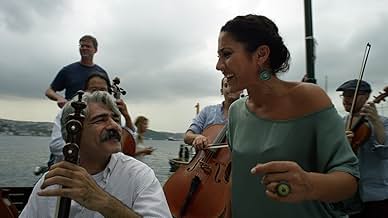The Music of Strangers: Yo-Yo Ma and the Silk Road Ensemble
Original title: The Music of Strangers
IMDb RATING
7.7/10
750
YOUR RATING
Cellist Yo-Yo Ma and other international artists of The Silk Road Project discuss their philosophies on music and culture.Cellist Yo-Yo Ma and other international artists of The Silk Road Project discuss their philosophies on music and culture.Cellist Yo-Yo Ma and other international artists of The Silk Road Project discuss their philosophies on music and culture.
- Awards
- 7 wins & 7 nominations
Storyline
Did you know
- TriviaA poster for this film can be seen in The Line Substitution Solution (2016) when the guys are waiting in line at the theater.
- ConnectionsEdited from From Mao to Mozart: Isaac Stern in China (1979)
Featured review
Music documentaries can be fascinating in many cases. This is the case of The Music of Strangers, the documentary produced and directed by Morgan Neville which tells the story of the wonderful musical adventure and inter-culture experience which is 'The Silk Road' ensemble and organization started in 1998 by the famous cellist Yo-Yo Ma.
The documentary deals both with the initial phases of the project (based on filmed material from their first encounters around the year 2000) and its later evolution. While the value of the cultural interaction is quite well presented, there is less mention if at all about the novelty of the approach of gathering together artists with very different backgrounds and having them play music in a fusion mode that was maybe acceptable in jazz, but much less in classical music where many of them (including Yo-Yo Ma) came from. Actually Ma is a pioneer from this perspective, using his almost pop star reputation to bring classical music to the wider audiences, but also the music of people and peoples to the classical musicians world.
There is no central story telling in the film which mainly builds itself by the interleaved personal stories told by Yo-Yo Ma and a few of the musicians, their own perspective about the work in the the ensemble, the interaction with other musicals, and their philosophies about the scope and the benefits of the project. We have the opportunity to meet Chinese lute virtuous Wu Man and hear her speaking about the challenges of learning and making music in China immediately after the Cultural Revolution, and Spanish bagpiper Cristina Pato about building her path as a woman artist in a less developed area of Spain, we see Syrian clarinetist Kinan Azmeh talking about his feelings about making music while his country is torn by war, and Iranian musician Kayhan Kalhor telling the story of his family broken by the political situation in his country and by exile. Most of all we see their opening to dialog and artistic collaboration, their passion of talking and especially playing music. A few of the meetings, concerts, family reunions and activities of volunteering with refugees are caught also on record.Watching them is a fascinating and beautiful cultural and musical experience.
The documentary deals both with the initial phases of the project (based on filmed material from their first encounters around the year 2000) and its later evolution. While the value of the cultural interaction is quite well presented, there is less mention if at all about the novelty of the approach of gathering together artists with very different backgrounds and having them play music in a fusion mode that was maybe acceptable in jazz, but much less in classical music where many of them (including Yo-Yo Ma) came from. Actually Ma is a pioneer from this perspective, using his almost pop star reputation to bring classical music to the wider audiences, but also the music of people and peoples to the classical musicians world.
There is no central story telling in the film which mainly builds itself by the interleaved personal stories told by Yo-Yo Ma and a few of the musicians, their own perspective about the work in the the ensemble, the interaction with other musicals, and their philosophies about the scope and the benefits of the project. We have the opportunity to meet Chinese lute virtuous Wu Man and hear her speaking about the challenges of learning and making music in China immediately after the Cultural Revolution, and Spanish bagpiper Cristina Pato about building her path as a woman artist in a less developed area of Spain, we see Syrian clarinetist Kinan Azmeh talking about his feelings about making music while his country is torn by war, and Iranian musician Kayhan Kalhor telling the story of his family broken by the political situation in his country and by exile. Most of all we see their opening to dialog and artistic collaboration, their passion of talking and especially playing music. A few of the meetings, concerts, family reunions and activities of volunteering with refugees are caught also on record.Watching them is a fascinating and beautiful cultural and musical experience.
Details
- Release date
- Countries of origin
- Official sites
- Languages
- Also known as
- Музыка чужестранцев
- Filming locations
- Istanbul, Turkey(multiple locations)
- Production companies
- See more company credits at IMDbPro
Box office
- Gross US & Canada
- $1,176,781
- Opening weekend US & Canada
- $24,614
- Jun 12, 2016
- Gross worldwide
- $1,259,588
Contribute to this page
Suggest an edit or add missing content

Top Gap
By what name was The Music of Strangers: Yo-Yo Ma and the Silk Road Ensemble (2015) officially released in Canada in English?
Answer


























